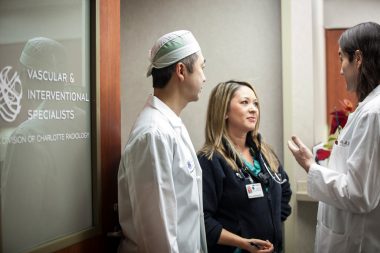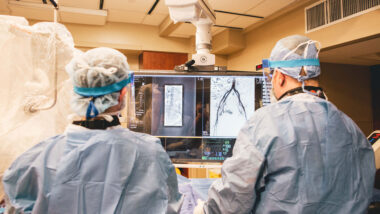When Silvia, who is in her mid-40s, began experiencing heavy periods, debilitating cramps and painful intercourse, she knew something was wrong.
“I spoke with my OB-GYN and explained my symptoms, and that’s when I was told I had uterine fibroids,” Silvia says. “Having just been diagnosed, I had limited understanding of available treatment options. I thought a hysterectomy was the only solution, and I was concerned this was more than I was prepared to commit to.”
Silvia’s OB-GYN, however, knew of a minimally invasive alternative to a hysterectomy — uterine fibroid embolization (UFE) — which would shrink uterine fibroids and greatly reduce or even eliminate symptoms. The OB-GYN referred Silvia to board-certified Vascular and Interventional Radiologist James Chen, MD, at Charlotte Radiology, who discussed the minimally invasive approach and excellent clinical outcomes of the UFE procedure. Silva was eager to proceed, and Dr. Chen performed the UFE for her. The results were transformative.
“Five to 10 days after my procedure, I felt normal,” Silvia says. “Fibroids controlled so much of my life that I now feel 100% better. I’m no longer experiencing heavy bleeding, and I feel better than ever.”
“When I met with Dr. Chen and his team, I was impressed. They explained every step of the process, from what UFE is, to what to expect during the procedure and the recovery process. Everything happened exactly as they said it would.”
— Silvia, UFE Patient
Read More: Uterine Fibroid Myths Debunked
A Burden on Women’s Health
If Silvia’s experience seems familiar to your own, you’re not alone. Most women in the U.S. will develop at least one uterine fibroid — a growth in the wall of the uterus — during their lifetime, typically when approaching menopause. While these growths are rarely cancerous, they can cause debilitating pain, heavy menstrual bleeding, fatigue, and other symptoms. Perhaps worst of all is how disruptive uterine fibroids can be. If you’re living with symptoms of uterine fibroids, you may feel like you are not in control of your life, forcing you to put things on hold until you feel better.
It isn’t just uterine fibroids that are widespread; so is the belief that a hysterectomy, or surgical removal of the uterus, is the only treatment option. While a hysterectomy is an effective uterine fibroid treatment, it may not be right for you, especially if you want to avoid surgery. Major surgery often requires an inpatient hospital stay, longer recovery times, and an increase in trauma to the body.
Fortunately, UFE only requires one small incision to shrink uterine fibroids and greatly reduce or eliminate symptoms, making it an effective alternative to major surgery.
Risk Factors for Uterine Fibroids
The exact cause of uterine fibroids is unclear, but experts believe that abnormal levels of the hormones estrogen and progesterone may contribute. These growths may also be hereditary, meaning they can run in families.
Several factors can increase your risk for uterine fibroids, including:
- Age. Your risk rises as you age, especially as you approach menopause, which typically occurs after 45.
- Dietary factors. Your risk may be higher if you eat a lot of red meat or use soy milk.
- Excess weight. Being overweight or obese is a risk factor for uterine fibroids.
- Having never been pregnant. Pregnancy may help protect against uterine fibroids.
- High blood pressure. This condition can put you at risk for uterine fibroids.
- Race. Black women have a higher risk of uterine fibroids.
- Vitamin D deficiency. Not getting enough vitamin D can increase your risk.
Uterine Fibroid Symptoms and Diagnosis
Some women with uterine fibroids don’t experience any symptoms and may not know fibroids are present until their OB-GYN feels the uterus as part of a routine pelvic exam. However, many women do experience symptoms of uterine fibroids. These symptoms may include:
- Frequent urination due to fibroids putting pressure on the bladder
- Heavy menstrual bleeding, which, in some cases, can lead to anemia
- Lower back pain
- Pain during sex
- Pelvic discomfort, pain or pressure
 If you have symptoms, especially if they interfere with your life, see your OB-GYN or primary care doctor. To diagnose uterine fibroids, your physician may perform a physical exam to feel your uterus for growths. Or they may use an ultrasound, an imaging exam that uses sound waves, to produce images of the uterus and ovaries. Other types of imaging that can also help diagnose uterine fibroids are MRI and CT.
If you have symptoms, especially if they interfere with your life, see your OB-GYN or primary care doctor. To diagnose uterine fibroids, your physician may perform a physical exam to feel your uterus for growths. Or they may use an ultrasound, an imaging exam that uses sound waves, to produce images of the uterus and ovaries. Other types of imaging that can also help diagnose uterine fibroids are MRI and CT.
Read More: Learn About Minimally Invasive Procedures
Uterine Fibroid Treatment Options
Your OB-GYN will work with you to select a uterine fibroid treatment that can provide relief and meet your goals.
- UFE is a non-surgical, minimally invasive treatment and a safe alternative to surgery. An interventional radiologist will use a catheter to send particles that block blood flow to the fibroids. With their blood supply taken away, the fibroids shrink. The treatment is fast, and you can go home the same day.
- Medications, including a class of medicines called gonadotropin-releasing hormone agonists, can reduce the size of fibroids. In addition, over-the-counter pain medications, such as ibuprofen, can help you manage discomfort. Birth control pills and hormonal intrauterine devices (IUDs) may lessen heavy bleeding.
- Myomectomy is a surgery that removes fibroids while preserving the rest of the uterus. To minimize any complications, your doctor may recommend iron supplements or hormonal treatment.
- Hysterectomy is a surgical procedure in which part or all of the uterus is removed. This procedure typically requires a hospital stay and a full recovery of several weeks.
Don’t let uterine fibroids control your life any longer. With the range of treatments available, many women do not need surgery. If you or someone you know is experiencing symptomatic uterine fibroids, we encourage you to follow in Sylvia’s path and reach out to your OB-GYN or primary care physician for your available options.
Request a UFE consultation with a Vascular and Interventional Radiologist.
Sources:
-
-
-
-
-
- https://www.womenshealth.gov/a-z-topics/uterine-fibroids
- https://www.nichd.nih.gov/health/topics/uterine
- https://www.acog.org/womens-health/faqs/uterine-fibroids
- https://www.radiologyinfo.org/en/info/ufe
- https://www.ncbi.nlm.nih.gov/books/NBK537747/#:~:text=Most%20women%20will%20develop%20one,fibroids%20during%20their%20reproductive%20lifespan.&text=In%20the%20United%20States%2C%20an,and%2050%20have%20uterine%20fibroids.&text=More%20than%2015%20million%20of,associated%20symptoms%20or%20health%20concerns
- https://medlineplus.gov/menopause.html
- https://www.youtube.com/watch?v=xvbMo0x2804
-
-
-
-



